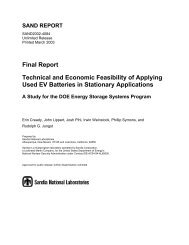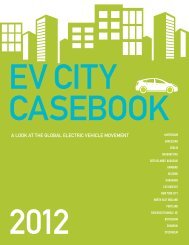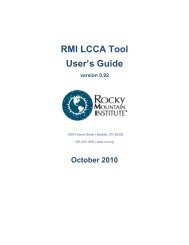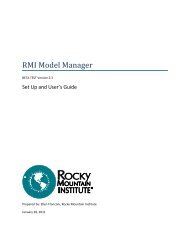Fleet Electrification Roadmap
Fleet Electrification Roadmap
Fleet Electrification Roadmap
- No tags were found...
You also want an ePaper? Increase the reach of your titles
YUMPU automatically turns print PDFs into web optimized ePapers that Google loves.
12 executive summaryfleet electrification roadmap13PART ONEThe Case for <strong>Fleet</strong>sPART TWO<strong>Fleet</strong> ChallengesThere were more than 16 million public and private fleetvehicles on the road in the United States in 2009. 13 Whilethe size of individual fleets varies significantly, the top50 fleet operators together manage more than half a millioncars and trucks. 14 These vehicles perform a variety ofmissions for federal, state, and local government, and forcompanies that are familiar to nearly all Americans. Theyare postal delivery vehicles, utility and telecommunicationsservice trucks, pharmaceutical sales vehicles, urbandelivery vans, and others.The concentration of buying power associated withfleet operators and fleet management companies representsa significant opportunity to assist the early developmentof the electric drive vehicle industry. Moreover,fleets tend to possess a handful of important characteristicsthat may make them more likely than typicalconsumers to take on the potential risks of electric driveownership in anticipation of reaping financial benefitsdown the road.Total Cost of Ownership Approach toAcquisition: When asked, fleet managersrank total cost of vehicle ownership as themost significant factor driving acquisitiondecisions. 15 Consumers, on the other hand,may purchase for a variety of reasons, includingaesthetics and style, in addition to cost.Route Predictability: The most costintensivecomponent in current-generationelectric drive vehicles is the battery. In caseswhere fleet vehicles have highly predictableroutes with little variation from day to day,batteries can be right-sized to minimizeexcess capacity, reducing added upfrontinvestment in excess energy storage.13 PRTM analysis; This figure is derived from a composite of data sources,including R.L. Polk & Co., Automotive <strong>Fleet</strong>, U.S. General ServicesAdministration, GE Capital, Utilimarc, and others.14 Bobit Publishing Company, 2010 Automotive <strong>Fleet</strong> Factbook (AFB),available online at http://www.automotive-fleet.com/Statistics/.15 EC, PRTM interviews with fleet managers.0%100%High Vehicle Utilization Rates: <strong>Fleet</strong>vehicles typically have higher utilizationrates than consumer vehicles. The result maybe that fleet operators can quickly recoup thehigher upfront costs of electric drive vehicles.Use of Central Parking Facilities: <strong>Fleet</strong>sthat make use of central parking depots maybe able to avoid dependence on public charginginfrastructure and benefit from economiesof scale in single-point installation ofmultiple chargers in individual facilities.Importance of Maintenance and ServiceCosts: Particularly in fleet applications thatoperate vehicles for longer periods of timeor into high mileage ranges, the low maintenancecosts of electric drive vehicles willrepresent a substantial cost savings.Lower Electricity Rates: The electricityrates paid by commercial and industrial consumers—thosemost likely to make use of fleetvehicles and central refueling—are often significantlyless than those paid by residentialconsumers. The fuel cost per mile traveled isone of the key economic factors differentiatingplug-in electric drive vehicles from othertechnologies.Alternative Business Models: Based ontheir access to capital and larger purchasingpower, fleet managers may benefit from alternativebusiness models that can help facilitateadoption of electric drive technology.Corporate Sustainability: Commercial andgovernment enterprises may also considerelectric drive vehicles in the context of corporatesustainability initiatives. GEVs can helpmeet reduced emissions and petroleum consumptiongoals.While fleet operators do possess a number of importantqualities that could facilitate their adoption of electricvehicles, they will also face challenges. Some of the basiccost and technology hurdles for individual consumers willalso be problematic for fleets, though fleets may be betterequipped to deal with them. In addition, fleet electrificationmay come with its own set of unique challenges thatcan be addressed through a combination of careful planningand public policy support.0Technology Costs: Battery costs associatedwith the first commercially available electricdrive vehicles will result in a substantial overallcost premium. Current battery technologyis descending the cost curve as volumesincrease, but under some fleet applications, itmay be difficult to realize a return on investmentin a reasonable time period. Ultimately,fleet operators may be more willing thanpersonal-use consumers to consider multiyearpaybacks, but they will still want to seereturns relatively quickly.Capital Expenditures vs. OperatingExpense: There is typically intense competitionfor capital within a given companyor institution. The high capital cost requirementsof today’s electric drive vehicles, particularlyin applications heavier than a passengerautomobile, will prove challenging formany fleet operators. Even extremely largebusinesses may be unwilling to tie up capitalto support substantial volumes of electricdrive vehicles.Battery Residual Value: Today, estimatingthe residual value of used large-formatautomotive batteries is an educated guess atbest. Early test data suggests that lithium-ionbatteries may still possess 70 to 80 percent oftheir ability to store energy when they are nolonger fit for automotive use. But this needsto be borne out by practical experience.<strong>Fleet</strong> Infrastructure Issues: Even for fleetsthat centrally park, the cost of installingcharging infrastructure may be significant.With Level II charger costs averaging $2,000per unit, the cost of installing enough chargersto support a fleet of several dozen EVs orPHEVs could be challenging. Level III chargingmay offer faster charge times and reducedunit requirements, but costs are still too high.Utility Impact of Dense Charge Networks:Bringing a fleet of EVs or PHEVs into asmall charging space will bring an unusuallyhigh burden to those areas and mayrequire upgrades to local utility distributionnetworks. In particular, transformers servingcharging facilities may be insufficientlyrobust to support the simultaneous chargingof multiple vehicles. Utilities will need accessto information and regulatory support to dealwith these and other issues.Market Perceptions: Perhaps the mostcritical challenge affecting fleet adoption ofelectric drive technology will be fleet adopters’impressions about the technology and itsability to meet their operational needs. Evenwhen a compelling economic case exists, fleetoperators will need to be confident that thevehicle can accomplish the mission.
















